#plant evolution
Text
Animation practice for an upcoming project for my class
#art#drawing#draw#procreate art#digital art#illustration#illustrations#artist#procreate#drawings#scientific illustration#science art#botany#botanical art#paleobotany#evolution#plants#plant history#natural history#plant evolution#animation#animatic#procreate app#procreate animation#animation process#2d design#bryophytes#pteridophytes#gymnosperms#angiosperms
16 notes
·
View notes
Text
A lethal pulse of ultraviolet (UV) radiation may have played a role in the Permian-Triassic mass extinction event, roughly 250 million years, fossilized pollen grains reveal.
Plants rely on photosynthesis to convert sunlight into energy, but they also need a mechanism to block out harmful UV-B radiation.
Dying in the Sun: Direct evidence for elevated UV-B radiation at the end-Permian mass extinction
#paleontology#mass extinction#permian#pollen samples#paleontologist#uv radiation#plant evolution#evolution#photosynthesis#science#biology
5 notes
·
View notes
Text
Hi all, and welcome to my worldbuilding project!
The story is set in a fantasy version of prehistoric Earth & centres on the sporophyll fairies. They're gijinka (anthropomorphisms) of vascular plant taxa which flourished from the Paleozoic to the Cretaceous.
I'll tag posts as "writing", "art" or "worldbuilding", as well as characters by name where they appear, for ease of navigation. The Index post contains links to individual chapters & other posts outlining the key info of the setting. Any questions or feedback, give me a shout & I'll do my best to answer.
May the winds be at your back!
1 note
·
View note
Text
The Sweet Sacrifice: Wild Field Pansies Evolve to Produce Less Nectar
As insect populations in Europe fall, some plants are turning to self-pollination.
Change is the essence of life, and this is no less true for the wild field pansy. This vibrant flower, a beloved staple of the American countryside, has been quietly evolving in ways that have significant implications for the ecosystems it inhabits. Recent research reveals that these pansies have gradually shifted towards self-pollination, producing less nectar in the process. But how has this…

View On WordPress
0 notes
Text
Okay, so this is really cool! You have this phenomenon where some plants grow edible appendages to their seeds to entice ants to carry them underground where they can safely sprout. And then you have wasps which lay their eggs on the leaves, stems, and other parts of plants and trigger the growth of galls (swellings) which both feed and protect the wasp larvae until they reach maturity.
The boy who was watching the ants noticed they were taking wasp galls underground, too. Further exploration found that the wasp larvae were unharmed inside the galls; the only thing the ants had eaten were edible appendages similar to those on the seeds they collected. The wasp larvae stayed safe inside the ant nest, feeding on their galls, until it was time to emerge and head back out to the surface.
So it turns out that the edible portions of the galls have the same sorts of fatty acids as the edible parts of the seeds. And those fatty acids are also found in dead insects. Scientists think that the wasps evolved a way to make the galls they created mimic the edible portions of the seeds to get the ants to collect the galls. This isn't the only example of wasps making use of ants as caretakers for their young, but it's a really fascinating example thereof--especially if you consider ants evolved from wasps at least 100 million years ago.
#wasps#ants#plants#galls#oak galls#insects#invertebrates#Hymenoptera#ecology#bugs#animals#wildlife#nature#trees#entomology#science#natural science#evolution#animal behavior
13K notes
·
View notes
Text
Euphorbia euphoria
Was sent this by a friend:
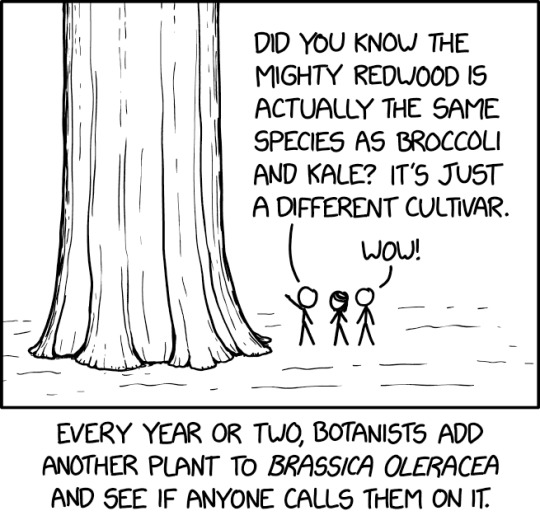
which is a reference to this:

namely, the fact that the wild mustard Brassica oleracea, once domesticated, produced a bewildering variety of vegetables by selecting each cultivar for a different part (cabbages from terminal buds, Brussels ssprouts from lateral buds, broccoli and cauliflower from flower buds, kale from leaves, and so on), all of them still being technically part of the same species, Brassica oleracea var. whatever.
Now, as far as I know, nobody has bred B. oleracea into a tree. But there is, not quite a single species, but a genus, that has gotten pretty close to that kind of internal morphological diversity:
Behold Euphorbia, the genus of spurges, counting over 2000 species (that nevertheless are often capable of interbreeding) scattered throughout all continents:

Euphorbia dendroides (Mediterranean)
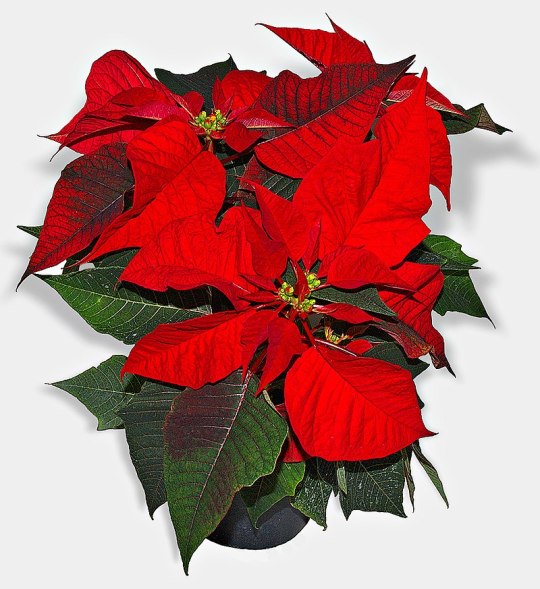
The poinsettia, Euphorbia pulcherrima (Central America)
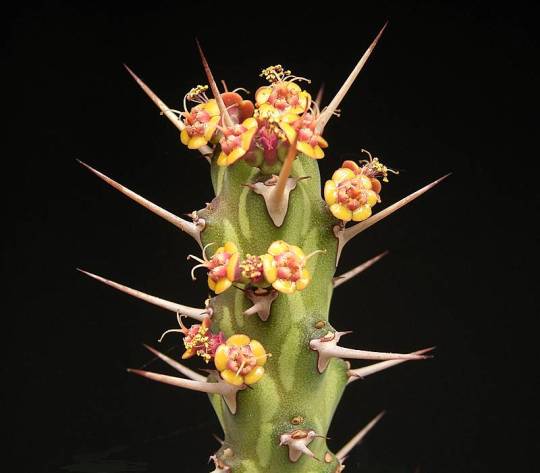
Euphorbia actinoclada (East Africa)|, one of the many cactus-like species (cacti proper are all American species except one, so if you see a cactus-like plant in an African or Asian deserts, odds are it's actually a kind of euphorbia)

Euphorbia trigona (Central Africa)

Euphorbia myrsinites (Southeast Europe)
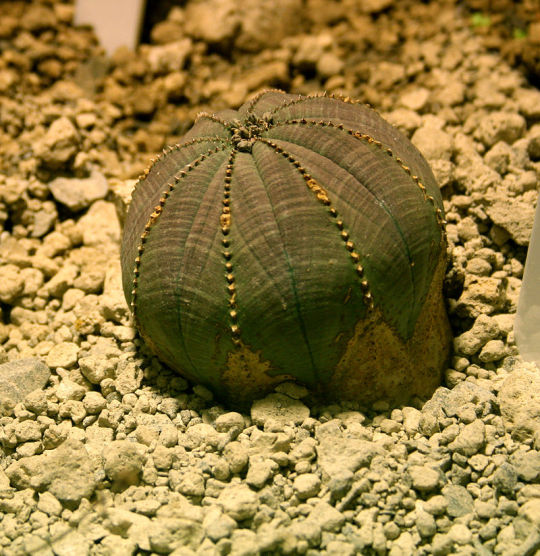
Euphorbia obesa (South Africa)
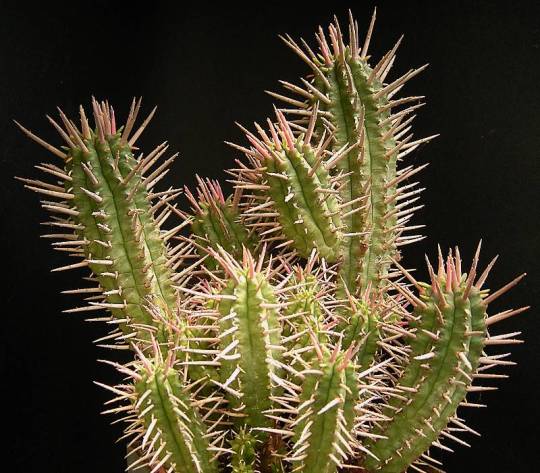
Euphorbia ferox (South Africa)
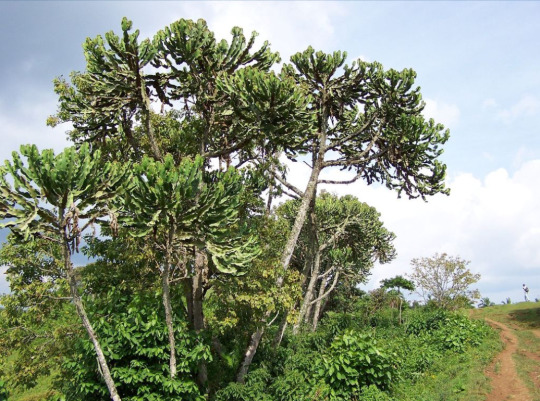
Euphorbia ampliphylla (East Africa) (source)
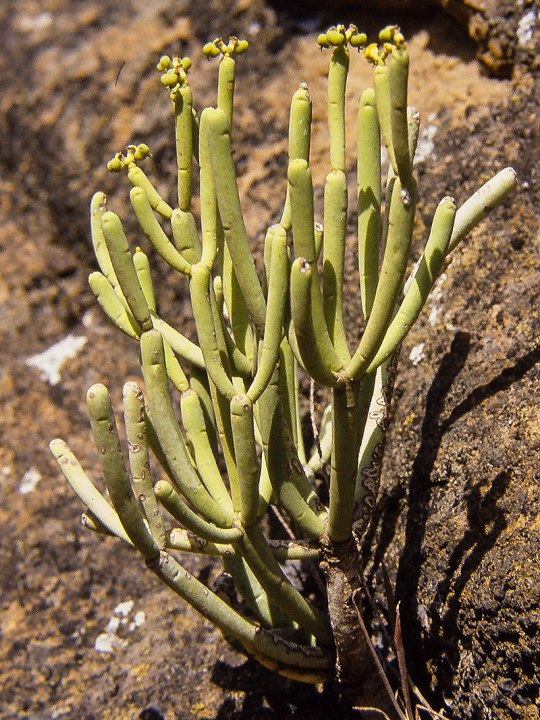
Euphorbia aphylla (Canary Islands)
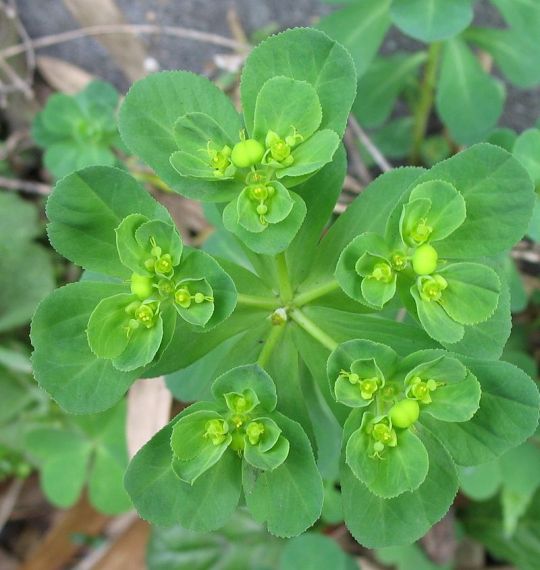
Euphorbia helioscopia (Eurasia and Africa)
And so on, and so on...
3K notes
·
View notes
Text








Bagworm caterpillars are known for their unique behavior of carrying logs to construct their protective cases. They use silk produced by specialized glands to attach these materials together, forming a sturdy and camouflaged shelter. The process typically involves the caterpillar cutting small pieces of vegetation, such as twigs, leaves, and bits of bark, and then attaching them to its body with silk. As the caterpillar grows, it continues to add more material to its case, which can become quite large in size relative to the caterpillar itself.
#nature#science#bugs#catepillar#naturecore#nature aesthetic#insects#moth#aesthetic#sciencecore#plants#whimsicore#forest#forest aesthetic#forestcore#fairycore#cabin#cabincore#log cabin#cool#mother nature#critters#evolve#evolution
335 notes
·
View notes
Text
While I'm on my disruptive Tolkien opinions kick:
Yes, obviously, he was a conservative Catholic and this was really important to his understanding of the world and pervades his work and so on and so forth.
But I'm a bit "..." about reducing everything he thought and felt about the world to that. Like, yeah, there's a tradition of conservative pastoralism that meant the context of his environmental opinions was not inherently progressive in the way it can mistakenly seem in 2024. Do I think he was Like That about trees because of conservative pastoralism, or his Catholicism, or that the particular form taken by his TREES TREES TREES #OLDMANWILLOWDIDNOTHINGWRONG TREEEEEEEEES ethos much resembles most of his contemporaries' feelings?
Not really.
I mean, he would never have said it, but I kind of doubt whether his very sincere and deeply felt veneration of the actual figures of his religion was truly comparable to how he felt about things like That One Oak on the Corner That I Liked Got Chopped Down by Evildoers. I've read other conservative British writers of this era who have their own forms of pastoralism and most of them are way less intense about it. I truly don't think Tolkien loved trees the way he did Because Catholicism or whatnot. I genuinely think he just really loved trees.
Basically, I can imagine some alternate universe in which alternate Tolkien ends up with really different beliefs about religion, about politics, about all sorts of things. But I can absolutely not imagine a universe in which any version of Tolkien did not take the part of trees against all their enemies.
#honestly easier to imagine au jrrt as a neopagan anarchist ecoterrorist than au jrrt as still conservative but pro industrialization#sorry my dude i know you had important opinions about the immaculate conception of mary and her uniquely unfallen nature etc#but i am not convinced you cared more about that than any random plant you passed on your nature walks#i was going to connect this to his evolution on early númenórean imperialism between lotr and the mariner's wife but alas i must dissertate#anghraine babbles#deep blogging#legendarium blogging#jrr tolkien#legendarium fanwank#also ... people joke about him representing his friend lewis as a tree person in lotr#but honestly given who jrrt was as a person i'm not sure he could envision a greater honor
234 notes
·
View notes
Text
Biologists have long known mushrooms of the genus Mycena, commonly known as bonnet mushrooms, as fungi that live off of dead trees and plants. New research from the University of Copenhagen demonstrates that bonnets can also find their ways into young, healthy trees and plants, where they try to cooperate. In doing so, they have made an evolutionary leap which challenges our understanding of the ecological roles of fungi.
Fungal spores float through the air. Thin strands of their mycelia creep along surfaces. They seek out defenseless hosts to wrap themselves around in webs of fungal growth. Their victims can then be used to satisfy their own need to devour and disperse.
That fungi have begun to invade the living is a horrific thought for anyone who ever thought that fungi only dined upon the dead. Or, at least for those who stream The Last of Us, a post-apocalyptic series in which humans battle relentless fungal-infected zombies.
Fortunately, reality is rarely so dramatic. But after Danish mycologists targeted local Mycena, known as bonnet mushrooms, it turned out that certain similarities emerged nevertheless.
New research from the University of Copenhagen's Department of Biology suggests that this genus of fungi, which has traditionally been considered saprotrophic—i.e., a decomposer of nonliving organic matter—is in the midst of an evolutionary leap. The research is published in the journal Environmental Microbiology.
"Using DNA studies, we found that Mycena fungi are consistently found in the roots of living plant hosts. This suggests that bonnets are in the process of an evolutionary development, from uniquely being decomposers of nonliving plant material to being invaders of living plants, under favorable conditions," explains Christoffer Bugge Harder, the study's lead author.
Continue Reading.
427 notes
·
View notes
Text
Predatory Bananas: an Evolutionary Horror
(Pls read, I literally spent HOURS on this <3)
A friend sent me the following video about the various potential methods of banana locomotion. It got me thinking. How would a banana move? Naturally, as an autist with a special interest in evolutionary biology, I took the joke a little too far and wrote a whole piece on the matter, analyzing the feasibility of each method and the changes they’d need to evolve in order to achieve them.
(Video courtesy of Burning Onion Animation on TikTok, they make great content, go check them out)
The first and most likely way bananas would move is if banana trees evolved to spread their seeds through their fruits rolling down hills like the morphology of #1 suggests. The only major mutations that need to happen are a more pronounced curve and increased rigidity to facilitate rolling and absorb the impact from falling from the tree. Overall, evolving to this point is relatively straightforward. #1 is the most feasible and realistic answer.
For bananas to develop motility like in #4 is theoretically possible with the right environmental pressures and with enough time, though much more difficult. I see this working in one of two ways. First, they could evolve rigid structures that change shape depending on moisture content, using natural dry/wet cycles to move a little more each time it rains, much like the seeds of Erodium Cicutarium (pictured below). The fruits of the banana tree would most likely evolve to have hooks on the end of said structures, contracting and pulling themselves forward a little each time they dry out, and relaxing and resetting their grip on the soil each time they get wet.
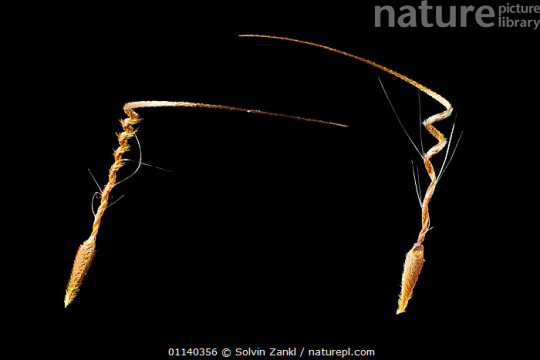
The second way I could see this happening is if they evolved true locomotion. True locomotion in bananas would take at least a few million years to evolve (probably more like tens of millions), and even then, movement would be incredibly slow. There exists a plant called the “walking palm” (socratea exorrhiza, pictured below) that’s capable of “walking” using its roots, but it can only travel about 20 meters per year in ideal conditions, and has the resources of the entire tree at its disposal, not just that of a single fruit.
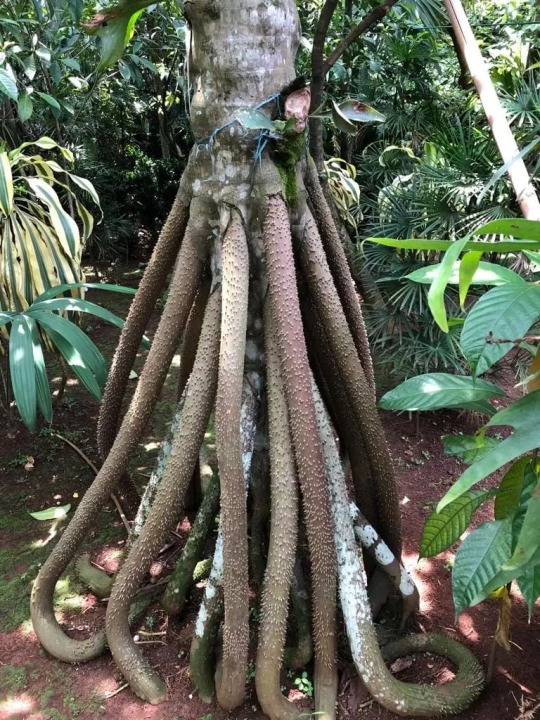
While this is the more likely explanation as to how #4 might happen, it’s not what the video depicts. The video clearly shows a banana dragging itself along like an inchworm, indicating motor cells such as those present in Dionaea Muscipula (venus flytrap, pictured below). Whenever this type of movement in plants occurs, it takes an extreme amount of energy and is generally rather inefficient and slow. In addition to this, the banana is moving its entire mass every time, so it’ll have to move much more slowly to compensate. This means that the banana would probably only be able to travel a few centimeters before decomposing beyond the point of functionality. After a few million more years it’s possible that bananas could evolve to travel as far as several meters after falling off the tree, but the further they go, the more fit each individual fruit needs to be, and the more energy and resources they need. Eventually, it’ll reach a point where the energy expenditure will outweigh the benefit and the fruits will stop evolving to travel any further, which I imagine would plateau somewhere in the 0.5 to 3 meter range. However, the fruits still require a significantly higher amount of energy at this point because they’ve evolved to move autonomously, so trees would likely evolve to produce fewer, but more developed fruits as a result. Overall this is the second most likely way bananas would evolve to move, but the video depicts a time lapse, not footage taken in real time.
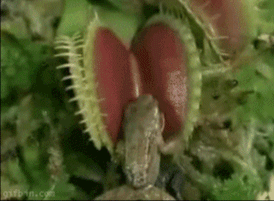
The next most likely option is #2, which is where things start to get much more interesting. At this point we are quickly beginning to leave the territory of the banana being a fruit and stepping closer towards the realm of the banana being its own independent organism. Whether the banana is still a single fruit from a larger tree depends on if the video is stabilized or not. First, let’s assume that the video has automatically stabilized the banana within the frame. This means that the banana is moving erratically and aimlessly, with the goal of simply moving as far from its origin as it can. The most simple form of this would be a ballistic dispersal method in which the banana grows curved and under tension, falling off the tree when ripe. Upon impact, the tension is released and banana extends, springing itself upward and outward with a single bounce. But this isn’t what the video shows either, it depicts clear and repeated movement, again suggesting the presence of motor cells much like those likely found in banana #4. In this case it probably evolved in roughly the same way as banana #4, but works less effectively due to having a less stable method of traveling.
But what if the video ISN’T stabilized, and the banana’s staying upright all on its own? In the video, the banana isn’t just moving along a single plane with one set of motor cells like the Venus flytrap. It’s full on galloping. This requires multiple groups of motor cells working together in a coordinated effort. This banana has real-time sensory input to orient and stabilize itself. This means that the banana has evolved some sort of internal gyroscope, much like our inner ear that helps it determine what up and down is, and more importantly, angular rotation. While plants have been observed reacting to and even predicting stimuli in ways that still baffle scientists to this day, this is far more complex than any plant every discovered throughout human history. Everything here points to something more, perhaps rudimentary intelligence, dare I even say sentience.
This begs the question: is it even a plant anymore? At this stage it’s evolved sensory organs and can move independently. But why? Organisms don’t evolve the ability to move without reason. This could mean one of three things. First, it could have evolved the ability to run as a means of spreading its seeds further. But this can’t be the answer. Moving more slowly would be way more efficient for a banana in terms of energy expenditure, and spreading seeds the old fashioned way is still perfectly viable, so it wouldn’t have evolved that way due to lack of necessity. This brings us to the first legitimate possibility: the banana is prey. If the banana were prey, then the ability to gallop most likely evolved as a means of escaping predators and to avoid being eaten. This is further evidence that the banana has evolved beyond being a humble plant as this goes completely against the purpose of fruits, which evolved to be eaten on purpose. Now, the banana’s goal isn’t to be eaten so that its seeds may be deposited elsewhere, its primary objective is to survive. At this point it’s relatively safe to assume that the banana no longer comes from a tree, and now reproduces through fragmentation, or perhaps even live birth. Its lack of leaves suggest that it’s evolved beyond being an autotroph and relying on photosynthesis. But if it no longer gets nutrients from a tree, how does it subsist? It must be getting its energy from somewhere. The most likely answer to this is that banana is a herbivore, and gets its energy from plant matter, which contains a lot of the same nutrients that the banana recently used to get by growing on a tree. Overall, this is the third most likely way the banana would evolve locomotion.
But what if it isn’t an herbivore? This brings us to the other possibility: the banana is a predator. The banana that concerns me the most is banana #3. While all the other bananas have undergone major changes to their morphology, banana #3 appears to be identical to any regular banana, yet it still moves. The only way that such movement could be possible is if the banana had some sort of internal mechanism that moves its center of mass around rather quickly within its outer shell, which also requires an internal gyroscope for balance. I know what you’re thinking; “but this is an incredibly complex mechanism, wouldn’t it be easier to evolve one of the other ways?” To which the answer is yes, it would. But this raises another question with an even more alarming answer: why didn’t it? The answer lies in the banana’s identical appearance to that of a typical Cavendish. Clearly, looking like an ordinary banana is central to its survival strategy. At this point, it’s evolved well past the point of being a fruit and has become the first of an entirely new kingdom of sentient creatures descended from plants.
According to my estimates from the video, banana #3 is only able to move at a pace of around a tenth of a meter per second, maybe a quarter or half of a meter at the most. This means that it probably didn’t evolve the ability to move as a means of running from predators. Based on the physics in the video, my best guess as to how the banana moves is through the use of mostly hollow internal chambers with a central mass (probably a calcified seed) suspended by tendons that can move in any direction, accelerating the banana in that direction. Here I’ve collaborated with the massively talented @pholidia to bring my ideas to light.

Picture it. You’re a lone banana farmer in South America. You’re out harvesting your crops when you see a single banana on the ground. It looks a little weird and bruised, but still totally edible. “No good in letting perfectly good produce go to waste” you think to yourself as you pick up the banana. You go to peel it when suddenly, you feel a sharp shooting pain through your hand. You drop the banana, then fall to your knees. You look around for the wasp or whatever it was that stung you, but you can’t find anything. You collapse in a heap on the ground, unable to control your body. It’s at this point you notice the banana start to move. “Are… are those teeth?” you think to yourself. At this point the venom has taken full effect. You are alone and completely paralyzed, unable to do anything besides observe the banana as it starts moving towards you. Sharp teeth and beady black eyes are fully visible now. It ambles towards you clumsily, moving almost as if it were being controlled by invisible strings like a marionette. It reaches you and starts to chew. It is at this moment that you discover, much to your horror, that the venom is merely a paralytic, and not an anesthetic. Helpless to the venom, you can do nothing but watch as your blood slowly drains out onto the ground as the creature consumes you. Slowly, your vision begins to fade to black. You pass out, either from the pain or the blood loss, you’re not really too sure. You take one last look at the creature, then you’re gone forever.
#biology#evolutionary biology#evolution#bananas#plants#darwin#science#botany#banana#r/196#196#r/196archive#/r/196#rule#meme#memes#shitpost#shitposting#autism#stem#cool#funny#plant#cooking#trees#fruit#unreality#joke#funny shit#funny post
230 notes
·
View notes
Text
Lacking chlorophyll Dodder (genus Cuscuta) has evolved a parasitic relationship with it’s host plants for water and nutrients. It invades its hosts using specialized structures called haustoria, which penetrate the host plant's vascular system to extract resources - sounds like a 1950s horror thriller. Not welcome on farms as it reduces crop yields.
95 notes
·
View notes
Text
Herbs and Spices of Teyvat: Liyue
Liyue is a region characteristic by its impressive geography, mainly its towering mountains and canyons that carve the land of Geo. This, apart from incredible landscapes, it creates a multitude of microclimates, in which an incredible diversity of flora can grow. And some of these, the people of Liyue have made use of them for their cooking.

Some of the more known ones are the Jueyun Chili, the Violetgrass, and the Qingxin.

The Jueyun Chili, obtained from the Jueyun Chili Plant (Capsicopunica graveolens) is a punicoid bush found wild in the northern lowlands of Liyue, but is cultivated elsewhere. Their fruits, especially their seeds and the oils the fruit secretes, have an extremely spicy, almost burning hot smell, due to high concentrations of capsaicin, and the reason why it is used in a lot of dishes in the local cuisine. This compound is however clearly meant to dissuade mammals like humans from eating it, as its dispersers are pigeons, immune to capsaicin.

The Violetgrass (Campanulocatena scandens) is a lithophytic labiate plant that can be found all across Liyue. Despite this distribution, and its very pleasant fragrance, it is not very commonly used. This is because obtaining it is not an easy task. As a lithophyte, it grows exclusively on rock crevices in walls, cliffs and other of the most inaccessible places of this very mountainous region. However, whoever manages to get a hand on some of these hard to acquire flowers, will be paid a good price for their effort.

The Qingxin (Qingxinia aspilus) is a rare, highly sought after plant in the region. This ground creeping berberid has very specific growth condition requirements, and thus can only be found at the highest peaks, where its underground rhizome helps the plant survive the intense cold. The part of the plant that is used are its sweet, almost translucent flowers, as the rest of the plant is bitter.
#genshin impact#art#illustration#clip studio paint#speculative evolution#fanart#plants and herbs#plants#botanical illustration#botany#pepper#geranium#campanula#liyue
137 notes
·
View notes
Note
What does agriculture and typical plants and animals used in food look like in different regions and cultures?
For the sake of brevity, my answer will only cover this part (but don't worry, I'm working on the plants (and invertebrates) as well) :
VERTEBRATE LIVESTOCK OF UANLIKRI

Thanks to a wide range of environments and intercontinental trade, Uanlikri boasts a wide variety of vertebrate livestock, some domesticated locally, others brought along by settlers from the other continental masses. Most livestock on Uanlikri are ceratopsians (some more highly derived than others).
Caviþ
Pronounced chavith. Caviþ are a highly derived species of ceratopsians originating from the Basin region. The wild species still exist, roaming the southern Basin plains in great hordes.
For the most part, caviþ are kept as beasts of burden and for their meat and leather. In most locales, they are unpopular compared to O'ohu, which are more powerful, meatier, more docile, and have more offspring at once. Nevetheless, keeping caviþ has its avantages: caviþ are smaller, hardy, tolerant of crowding, and produce rough but warm pelts.
In general, caviþ are too small to be ridden by adult antioles, but not for the Apinaat and Abimaat, two peoples of pigmies who make their living on caviþback across the southern Basin plains and on the Matar Peninsula. For the Apinaat and Abimaat, caviþ, wild and domestic, are their whole livelihood. Their use of caviþ as mounts gives them an incomparable edge in warfare and has earned them a fearsome reputation.
Wek
Wek are one of the few non-ceratopsian livestock originating from Uanlikri. They were first domesticated in coastal areas of the Pwetitwì range from large gull-like birds, and spread from there to most northern coastal areas of Uanlikri. Wek are meaty and adaptable birds kept for their eggs, plumage, and guano. They require access to open water to thrive, but accept saltwater and freshwater alike. They are primarily kept in coastal areas, as well as along the Koramme river and Basin Great Lakes, where the slow-moving waters suit them fine.
Kabi
Kabi, a guinea pig sized ceratopsian, are the most widely kept livestock on Uanlikri. The kabi in the picture was enlarged for ease of viewing: the vast majority of kabi breeds are much smaller, though giant breeds do exist. Kabi are a multi-purpose livestock: they are bred for their meat, abundant eggs, soft patterned pelts, and companionship. Kabi are extremely adaptable and very tolerant of crowding. Their ease of keeping in urban environments has made them ubiquitous through all the cities of the continent.
There are hundreds of kabi breeds and landraces on the continent. Kabi have a tendency to establish themselves as feral pests as well as livestock, where natural selection by the environment encourages the development of landraces best adapted to the local climate. They also make excellent pets due to their highly social nature, and many lines of kabi are bred purely for good temperament and pleasing (though sometimes extreme) appearance. Kabi are also ubiquitous overseas: it is unclear where they were first domesticated, but most theories point towards dwarf and standard kabi originating from one domestication event on Uanlikri, and red-leg kabi originating from another domestication event overseas, possibly of a different but related species: this would explain some of the difficulties in breeding dwarf and standard kabi to red-leg kabi.
Tsut
Tsut were one of the livestock species brought along by the Senq Ha Empire, conquerors and settlers of the Western Peninsula. These diminutive therizinosaurids were selected through millenia for an extremely downy, frizzy coat which can be sheared and spun like wool. Of all Senq Ha livestock, tsut were the ones to find the fastest and most widespread adoption, only limited by their destructive browsing habits and preference for hilly terrains and cool weathers. Tsut down revolutionized the world of textiles in Uanlikri, where spun-down fibres were previously very rare and very expensive, requiring capture and shearing of wild animals with very little suitable fibre.
Tsut are primarily raised for their fiber but also provide meat and more importantly crop-milk. Consumption of crop-milk is slow to catch in communities not descended from the Senq Ha, but the Senq Ha's people use crop milk abundantly, using it fresh or processed in dozens of different ways.
Llekme
Llekme were domesticated in the Northern peninsulas of Uanlikri from a species related to the caviþ. They share many of the caviþ issues and advantages, being hardy but temperamental. However, contrarily to the caviþ, they are an extremely popular livestock among both sedentary and nomadic populations Uanlikri's north. There, they are used as beasts of burdens and pulling animals of limited power as well as for their meat. For the desert nomads of the Atashir, llekme provide essential help in carrying their tents and tools; in cities, they are often used as pulling animals, working alone or in teams to pull small carts and coaches.
Hêtâ
Hêtâ are family of highly derived ceratopsians, including a dozen species and subspecies on the mainland and a few endemic island species. They are, in truth, not yet a domestic species. All species of hêtâ are game animals highly appreciated for their ornemental feathers and delicious meat, and there have been several attempts to domesticate various species of mainland hêtâ, none of which have been successful. Mainland hêtâ have extremely nervous dispositions, are prone to dying from stress, and mostly fail to reproduce in captivity: they rarely breed, and when they do, they most often do not provide parental care, leading to the death of the chicks.
This said, there is an ongoing project on the Ojame archipelago to restore and domesticate the near-extinct Ojame hêtâ. The Ojame hêtâ is endemic to the archipelago. Due to the absence of large predators on the archipelago, it has evolved to be larger and much less fearful than mainland hêtâ, but was driven to near extinction by hunting and the introduction of larger, bolder breeds of oujabe [dog analogue] from the mainland and of continental hêtâ imported for use as wild game.
The failure of mainland domestication attempts and a joint desire to preserve and profit from the Ojame hêtâ has led to a unique, unusually coordinated project to domesticate and reestablish the Ojame hêtâ. In a rare show of goodwill and collaboration, this project is shared by both Wetki and Ranaite communities on the archipelago. The Ojame hêtâ is thought to be a promising source of meat and ornemental feathers as its population levels rise and stabilized. Successful captive reproduction has been achieved, and semi-domesticated captive population are being reintroduced to Êrar, the archipelago's largest island where the hêtâ had been completely eradicated.
Wagwacguk
The wagwacguk (wag-wash-guk) is a wild animal living as familial herds in the tundras south of the Kantishian, with a domestic subspecies of marginal range in the lands of the Daghwa-Igdø and the Kantishian High Plateau. It is a large, extremely hardy animal with a warm, plush coat and thick leather. For the Daghwa-Igdø, wagwacguk are their main livelihood. One month per year, they feast on the fresh meat of wagwacguk calves, culling their herds as the first dayfrosts touch their lands; the later kills are preserved by smoking and freezing. The rest of the year, wagwacguk blood provides them with most of the protein in their diet. Wagwacguk pelts, leather, guts, horn and hooves are the materials involved in most of their material culture.
Though domestic wagwacguk are most closely associated with the Daghwa-Igdø, they are also kept by the Oubixwø-øi of the Kantishian high plateau as part of the Oubixwø-oi's diverse survival strategies.
O'ohu
O'ohu are domestic hadrosaurs named, in most regions where they are kept, after their loud and haunting cry. They are the largest and second-most widespread livestock on Uanlikri. Where they are kept, they are invaluable for their work as beasts of burden: plowing fields, pulling carts, carrying charges of all kinds. They are essential to the work of peasants and armies alike, and they are surprisingly fast. Historically, they have often been used in active combat, pulling war chariots. They cannot be ridden: their back ridge is too fragile to bear the weight of a rider and their alternatively bipedal and quadrupedal gait makes balancing a saddle impossible. They are also used for meat, blood, leather, and other byproducts. Their finely scaled and patterned leather is considered especially attractive, and their hollow horns are often made into music instruments. In many cultures, O'ohu grastroliths are considered to have medicinal properties as the ultimate digestive aid, and are often sold at a considerable markup by gastrolith merchants.
#worldbuilding#uanlikri#speculative biology#speculative evolution#dinosaur#antiole world#art by me#asks#feel free to send the agriculture and plants asks again btw i'm working on it I just felt this would get wayyy too long#caviþ#chavith#kabi#llekme#wek#hêtâ#heta#tsut#wagwacguk#o'ohu#long post
64 notes
·
View notes
Text
Spectember/Spectober 2023 #09: Things With Wings
(Apologies for the abrupt absence – I'm okay, just having everything break down at once. This is fine.)
So— back to the speculative evolution request list!
@thebigdeepcheatsy requested a "cactus-dwelling/germinating evolution of introduced rosy-faced lovebirds":
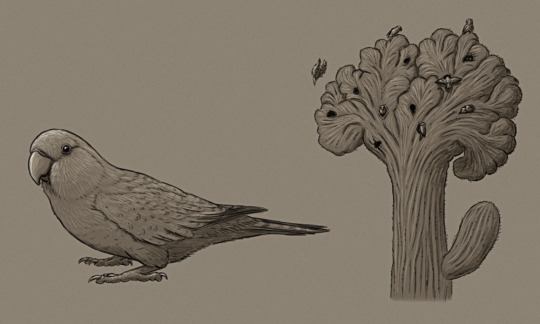
While Agapornis cheatsyi is still quite physically similar to its introduced ancestors, this lovebird has developed a close symbiotic relationship with the cactus Carnegiea ornipolis, a descendant of the modern saguaro.
Naturally fasciated, this cactus grows a splaying fan-like crown which the lovebirds excavate their shallow nest burrows into. Feeding on the cactus' fruit in early summer, the lovebirds then disperse the seeds via their droppings – a process that significantly improves propagation chances, both due to the birds commonly foraging and defecating around suitable nurse plants and the passage through their gut speeding up germination.
———
Someone calling themself "LB" asked for some "flying afrotherians":

Elbeitandraka venenifer is a descendant of tree-climbing Malagasy tenrecs that developed gliding membranes – and its lineage is now just about achieving true powered flight.
About 25cm long (~10"), its proportionally short broad wings require it to fly very fast to generate enough lift for its weight. It mostly only actively flies when traveling between roosts and feeding sites (or when escaping from threats), alternating between gliding to save energy and flapping to recover altitude.
It's an opportunistic omnivore, crawling around in the tree canopy foraging for vegetation, fruits, fungi, invertebrates, and the occasional smaller vertebrate, using its flexible sengi-like nose to probe around in crevices.
Much like modern common tenrecs it's capable of hibernating for months at a time through periods of scarce food availability. It also accumulates alkaloid toxins in its body from its arthropod prey, advertising its unpalatability to predators with bold contrasting warning coloration on its wing membranes.
———
And here's a combination of a couple of anonymous requests for both "flying heterodontosaurs" and "dragons with hind leg wings, a la sharovipteryx":
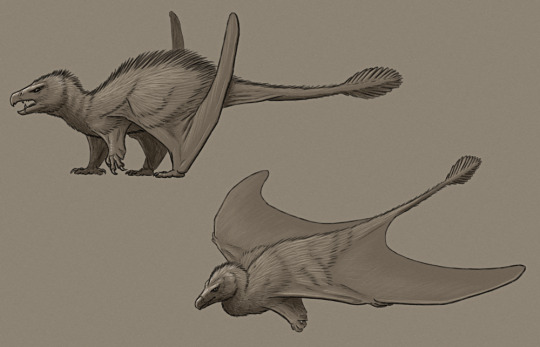
Inversodraco rapax is a highly specialized Jurassic descendant of heterodontosaurids that took to climbing and gliding, developing delta-wing-like membranes on their hindlimbs convergently similar to those of the earlier sharovipterygids.
Around 75cm long (~2'6"), it has unusually flexible hip joints for a dinosaur, able to splay its legs out to the sides to deploy wings supported by an elongated outer toe on each foot. Its arms form small forewings for stability, and its long tail ends in a vane of stiffened feathers that aid in steering.
Unlike its herbivorous-to-omnivorous ancestors it's primarily a carnivore, swooping down onto small prey and grabbing it with its talon-like forelimbs.
#spectember#spectober#spectember 2023#speculative evolution#lovebird#parrot#bird#saguaro#cactus#plant#tenrec#afrotheria#mammal#heterodontosaurid#ornithischia#dinosaur#art#science illustration#look if any mammal is going to copy bats' homework it's going to be tenrecs
290 notes
·
View notes
Photo
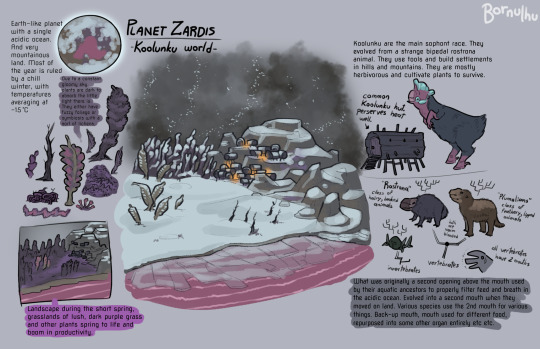
Some basic reference/introductory to the Koolunku world. And finally gave their planet a name and wrote down some info that had in mind for it for a while now but never really showed.
#creature design#Speculative Evolution#alien species#original creature#sophont#alien world#alien plants#alien art#spec evo#koolunku world#cold weather#worldbuilding
389 notes
·
View notes
Text
Another ridiculously cool thing I learned on jstor: in Spain and France, teosinte (the wild ancestor of maize) has become a nasty agricultural weed, and has obtained herbicide resistance from crossing with herbicide-resistant maize, as well as altering its lifecycle to adapt to Europe.
I'm becoming so fascinated with weed science. It's all like "We didn't know plants could evolve something this effective and beneficial with this few fitness costs this fast."
Like, weed science is constantly pushing back the line of what we "know" about how fast evolution can progress and that's so cool. These plants are so badass and I love it.
279 notes
·
View notes